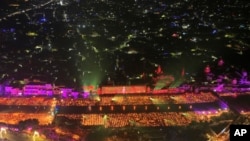Indians Set World Record Celebrating Diwali as Worries About Air Pollution Rise
Indians Set World Record Celebrating Diwali as Worries About Air Pollution Rise Voice of America - VOA News


Diwali Celebrations in India Set Guinness World Record for Lighting Earthen Oil Lamps
LUCKNOW, India
Millions of Indians celebrated Diwali on Sunday with a new Guinness World Record number of bright earthen oil lamps as concerns about air pollution soared in the South Asian country.
Across the country, dazzling multicolored lights decked homes and streets as devotees celebrated the annual Hindu festival of light symbolizing the victory of light over darkness.
But the spectacular and much-awaited massive lighting of the oil lamps took place — as usual —at Saryu River, in Ayodhya in Uttar Pradesh state, the birthplace of their most revered deity, the god Ram.
At dusk on Saturday, devotees lit over 2.22 million lamps and kept them burning for 45 minutes as Hindu religious hymns filled the air at the banks of the river, setting a new world Record. Last year, over 1.5 million earthen lamps were lit.
After counting the lamps, Guinness Book of World Records representatives presented a record certificate to the state’s top elected official Yogi Adityanath.
Over 24,000 volunteers, mostly college students, helped prepare for the new record, said Pratibha Goyal, vice chancellor of Dr. Ram Manohar Lohia Avadh University, in Ayodhya.
Diwali Celebrations and Sustainable Development Goals
- Goal 3: Good Health and Well-being
- Goal 7: Affordable and Clean Energy
- Goal 11: Sustainable Cities and Communities
- Goal 13: Climate Action
- Goal 16: Peace, Justice, and Strong Institutions
Diwali, a national holiday across India, is celebrated by socializing and exchanging gifts with family and friends. Many light earthen oil lamps or candles, and fireworks are set off as part of the celebrations. In the evening, a special prayer is dedicated to the Hindu goddess Lakshmi, who is believed to bring luck and prosperity.
Over the weekend, authorities ran extra trains to accommodate the huge numbers trying to reach their hometowns to join family celebrations. The festival came as worries about air quality in India rose. A “hazardous” 400-500 level was recorded on the air quality index last week, more than 10 times the global safety threshold, which can cause acute and chronic bronchitis and asthma attacks.
But on Saturday, unexpected rain and a strong wind improved the levels to 220, according to the government-run Central Pollution Control Board.
Air pollution levels are expected to soar again after the celebrations end Sunday night because of the fireworks used.
Last week, officials in New Delhi shut down primary schools and banned polluting vehicles and construction work in an attempt to reduce the worst haze and smog of the season, which has posed respiratory problems for people and enveloped monuments and high-rise buildings in and around India’s capital.
Authorities deployed water sprinklers and anti-smog guns to control the haze and many people used masks to escape the air pollution.
New Delhi tops the list almost every year among the many Indian cities with poor air quality, particularly in the winter, when the burning of crop residues in neighboring states coincides with cooler temperatures that trap deadly smoke.
Some Indian states have banned the sale of fireworks and imposed other restrictions to stem the pollution. Authorities have also urged residents to light “green crackers” that emit less pollutants than normal firecrackers. But similar bans have often been disregarded in the past.
The Diwali celebrations this year were marked as authorities prepared to inaugurate in January an under-construction and long-awaited temple of the Hindu god Ram at the site of a demolished 16th-century Babri mosque in Ayodhya city in Uttar Pradesh state.
The Babri Masjid mosque was destroyed by a Hindu mob with pickaxes and crowbars in December 1992, sparking massive Hindu-Muslim violence that left some 2,000 people dead, most of them Muslims. The Supreme Court’s verdict in 2019 allowed a temple to be built in place of the demolished mosque.
SDGs, Targets, and Indicators Analysis
1. Which SDGs are addressed or connected to the issues highlighted in the article?
- SDG 3: Good Health and Well-being
- SDG 11: Sustainable Cities and Communities
- SDG 13: Climate Action
- SDG 16: Peace, Justice, and Strong Institutions
The article discusses the issues of air pollution and its impact on health, as well as the construction of a temple at the site of a demolished mosque, which relates to peace, justice, and strong institutions.
2. What specific targets under those SDGs can be identified based on the article’s content?
- SDG 3.9: By 2030, substantially reduce the number of deaths and illnesses from hazardous chemicals and air, water, and soil pollution and contamination.
- SDG 11.6: By 2030, reduce the adverse per capita environmental impact of cities, including by paying special attention to air quality and municipal and other waste management.
- SDG 13.1: Strengthen resilience and adaptive capacity to climate-related hazards and natural disasters in all countries.
- SDG 16.7: Ensure responsive, inclusive, participatory, and representative decision-making at all levels.
The targets mentioned above are relevant to the issues of air pollution, environmental impact, climate-related hazards, and decision-making related to the construction of the temple.
3. Are there any indicators mentioned or implied in the article that can be used to measure progress towards the identified targets?
- Number of deaths and illnesses related to air pollution
- Air quality index levels
- Adoption of measures to reduce environmental impact in cities
- Resilience and adaptive capacity to climate-related hazards
- Inclusive and participatory decision-making processes
The article mentions the air quality index levels, the measures taken to reduce environmental impact in cities, and the decision-making process related to the construction of the temple. These indicators can be used to measure progress towards the identified targets.
Table: SDGs, Targets, and Indicators
| SDGs | Targets | Indicators |
|---|---|---|
| SDG 3: Good Health and Well-being | 3.9: By 2030, substantially reduce the number of deaths and illnesses from hazardous chemicals and air, water, and soil pollution and contamination. | – Number of deaths and illnesses related to air pollution |
| SDG 11: Sustainable Cities and Communities | 11.6: By 2030, reduce the adverse per capita environmental impact of cities, including by paying special attention to air quality and municipal and other waste management. | – Air quality index levels – Adoption of measures to reduce environmental impact in cities |
| SDG 13: Climate Action | 13.1: Strengthen resilience and adaptive capacity to climate-related hazards and natural disasters in all countries. | – Resilience and adaptive capacity to climate-related hazards |
| SDG 16: Peace, Justice, and Strong Institutions | 16.7: Ensure responsive, inclusive, participatory, and representative decision-making at all levels. | – Inclusive and participatory decision-making processes |
Behold! This splendid article springs forth from the wellspring of knowledge, shaped by a wondrous proprietary AI technology that delved into a vast ocean of data, illuminating the path towards the Sustainable Development Goals. Remember that all rights are reserved by SDG Investors LLC, empowering us to champion progress together.
Source: voanews.com

Join us, as fellow seekers of change, on a transformative journey at https://sdgtalks.ai/welcome, where you can become a member and actively contribute to shaping a brighter future.








